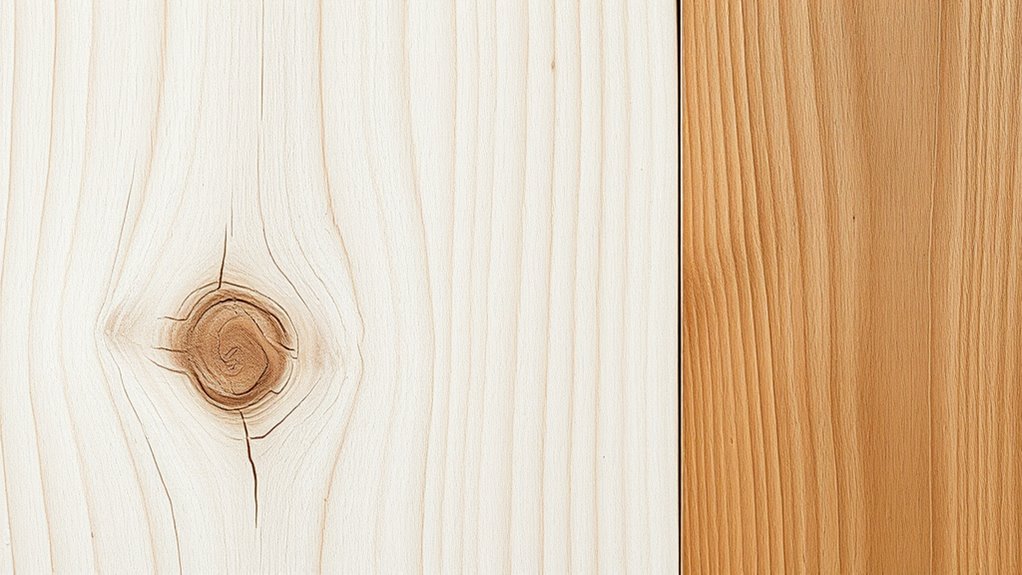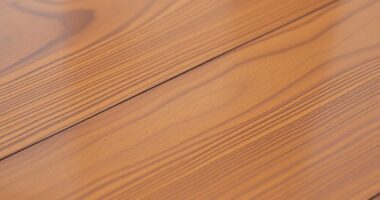Bleaching dark woods can instantly brighten their appearance, giving you a sleek, contemporary look that emphasizes natural grains and textures. By removing existing stains or deepening hues, you reveal the wood’s true character and create a more uniform finish. Proper preparation, including cleaning and testing, guarantees successful results. Eco-friendly options are available, making this process both stylish and sustainable. To discover effective techniques and tips for achieving stunning, lightened wood surfaces, keep exploring these methods further.
Key Takeaways
- Bleaching transforms dark wood into a bright, modern appearance by emphasizing natural grains and textures.
- Proper surface preparation and testing ensure effective, even lightening results tailored to wood type.
- Eco-friendly bleaching agents reduce environmental impact compared to traditional staining or painting.
- Bleaching restores aged or stained wood, revealing its natural hues for a clean, contemporary aesthetic.
- Suitable for furniture, floors, and accents, bleaching enhances wood’s character while achieving a sleek, modern look.

Ever wondered how to lighten and brighten aged or stained wood? If you’re aiming to restore or update your wooden surfaces, bleaching offers a practical solution that can transform dark, dull wood into a fresh, contemporary look. When you bleach wood, you’re fundamentally removing or reducing the existing stains and colorants, allowing the natural wood grains to stand out more vividly. This process highlights the unique patterns and textures inherent in the wood, giving your project a more authentic and appealing appearance. It’s especially effective for woods that have darkened over time or been stained unevenly, helping you achieve a more uniform, bright finish that complements modern design aesthetics.
One of the key benefits of bleaching is that it works with the natural wood grains, emphasizing their beauty rather than masking or disguising them. Unlike staining, which adds a new layer of color, bleaching gently strips away the old hues, revealing the underlying natural hues and textures. This approach allows you to preserve the integrity of the wood’s original character while achieving a lighter, more refined look. Additionally, bleaching can be a more environmentally friendly option compared to chemical staining or painting, especially when you choose eco-conscious products. Many bleaching agents are formulated to minimize environmental impacts, reducing the release of harmful chemicals into the air and water. This makes bleaching not only a practical choice but also a responsible one for eco-aware homeowners and artisans.
Bleaching enhances wood’s natural grains while being an eco-friendly, character-preserving finishing option.
However, it’s important to understand that bleaching isn’t a one-size-fits-all solution. The type of wood you’re working with, its age, and the extent of staining or darkening all influence how effective the process will be. Some woods respond better to certain bleaching agents, and you may need to experiment with small sections first. Proper preparation, including cleaning and sanding the surface beforehand, ensures even application and maximum results. Safety should also be a priority; always work in well-ventilated areas and wear protective gloves and goggles, especially when handling chemical agents.
Ultimately, bleaching your wood can help you create a clean, bright aesthetic that aligns with modern trends. It restores the natural beauty of the wood grains while minimizing environmental impacts, making it an attractive choice for sustainable, stylish renovations. Whether you’re refinishing furniture, floors, or decorative accents, understanding how to properly bleach wood empowers you to achieve stunning, contemporary results that showcase the true character of your wood surfaces.
Frequently Asked Questions
Does Bleaching Weaken the Wood’s Structure?
Bleaching can weaken the wood’s structure because of the bleaching effects, which may break down lignin and cellulose fibers. This reduces the overall wood integrity, making it more susceptible to damage or wear over time. If you decide to bleach your wood, make certain you follow proper procedures and avoid over-bleaching, so you maintain as much strength and durability as possible while achieving the desired lightening effect.
Can Bleaching Remove All Types of Wood Stains?
You wonder if bleaching can erase all wood stains, revealing a fresh, uniform canvas. While bleaching can considerably lighten many stains, it doesn’t always achieve perfect color uniformity or remove every discoloration, especially stubborn or deep-set ones. Think of it as gently fading a vibrant painting; some hues might linger, and the wood grain still whispers its unique story beneath the lightened surface.
How Long Does the Bleaching Process Typically Take?
The bleaching duration for your wood surface varies depending on the wood type and stain depth, but it generally takes between 30 minutes to several hours. You should monitor the process closely, checking frequently to achieve the desired lightness without over-bleaching. Remember, thinner coats or shorter periods can help prevent damage. Always follow the product instructions and test on a small area first to determine the suitable bleaching duration for your project.
Is Bleaching Suitable for Outdoor Wood Projects?
Yes, bleaching can be suitable for outdoor wood projects if you’re okay with the effects of wood weathering and natural aging. It helps lighten dark woods, giving a fresh look, but keep in mind that exposure to sun and rain will still cause the wood to weather over time. To maintain the desired appearance, you might need to re-bleach or seal the wood periodically, ensuring your project stays vibrant longer.
What Are the Environmental Impacts of Wood Bleaching?
You might think bleaching is harmless, but it can harm the environment with chemical runoff and waste. While traditional bleaching uses harsh chemicals, eco-friendly alternatives like hydrogen peroxide or natural solutions reduce ecological impact. Always consider chemical safety, ensuring proper handling and disposal. By choosing these safer options, you protect ecosystems, promote sustainability, and minimize your project’s environmental footprint, making your wood lightening process more responsible and eco-conscious.
Conclusion
By gently embracing the art of bleaching, you can subtly transform dark woods into a refined, contemporary charm. This delicate process allows you to craft a lighter, more airy ambiance without sacrificing the wood’s natural beauty. With patience and care, you’ll discover how a touch of lightening can beautifully redefine your space, offering a fresh, modern elegance. So go ahead—lighten up and let your creative spirit shine through in every grain.









